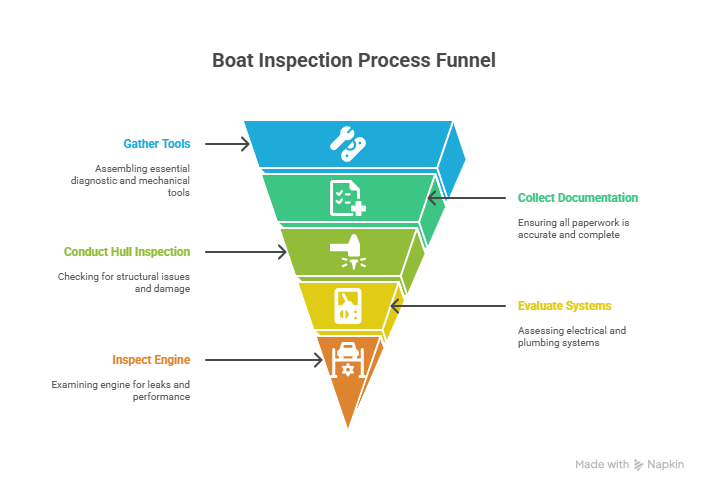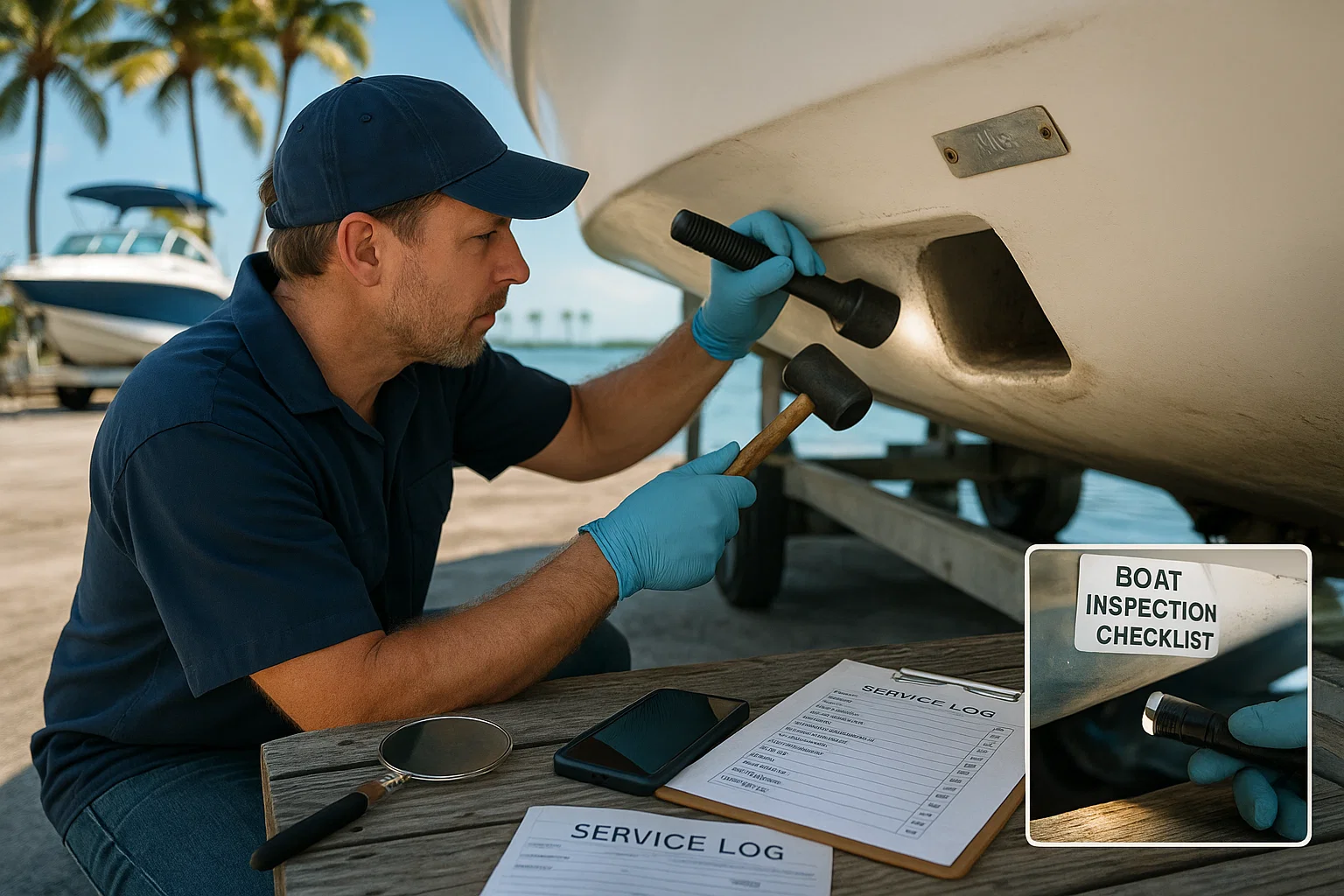Inspection Boat – The Real-World Guide from a Florida Mechanic
I’ve been wrenching on boats in South Florida for over 15 years, from Miami marinas to Fort Lauderdale slips, and let me tell you, nothing beats a solid inspection boat process to spot trouble before it sinks your wallet. That shiny hull at Bahia Mar might look perfect, but I’ve seen enough hidden rot and wiring messes to know better. Inspection boat isn’t just a quick look—it’s your shield against money pits. Yeah, I’ve pulled apart engines at Dinner Key that owners thought were fine, only to find corrosion that could’ve been caught early. Let’s break this down like I’d chat with you over coffee at the dock—prep, tools, paperwork, and when to walk away. Inspection boat done right has saved my clients thousands, and it’ll do the same for you.
Table of Contents
Preparing for a Thorough Inspection Boat
Listen, a good inspection boat starts way before you step aboard. I’ve shown up to jobs in Coconut Grove where owners skipped the basics, and bam—major oversights like mismatched HIN numbers that turned into legal headaches. Proper prep is your best bet against those hidden gems that turn into expensive repairs. I remember last summer, a guy named Ray at Key Biscayne thought he could wing it on a used Sea Ray; ended up with a soft deck that cost him $2,500 to fix because he didn’t bring the right gear. Inspection boat prep isn’t fancy—it’s practical, and it keeps you from getting burned in our salty humidity.
Assembling Your Inspection Boat Toolkit
Having the right tools turns a casual glance into a real inspection boat deep dive. I don’t lug around a full shop, but my kit’s saved me from bad calls more times than I can count. Take that time with Carla’s Boston Whaler off Stiltsville—my flashlight revealed bilge gunk that a naked eye would’ve missed. Here’s what I pack for every inspection boat gig:
- Essential Diagnostic Tools: A high-powered flashlight to probe dark spots like engine bays, an inspection mirror for those tight engine corners, and my smartphone for snapping pics of weird wiring.
- Simple Mechanical Tools: Screwdriver set to poke at fittings, and a percussion mallet—tap the hull, listen for thuds that scream delamination. I learned this trick the hard way on a Jon boat in Biscayne Bay; a dull sound meant waterlogged core, and it wasn’t pretty.
I put this table together from inspection boat jobs I’ve done in Miami—shows average costs if you skip tools and have to hire out fixes later. It’s rough, based on real hulls I’ve tapped.
| Tool/Issue | Why It’s Key in Inspection Boat | Average Fix Cost if Missed (Miami) | My Tip from Experience |
|---|---|---|---|
| Flashlight/Bilge Check | Spots hidden water damage or leaks | $300–$1,000 | Always check for standing water—saved a client’s weekend once. |
| Mallet/Hull Tap | Detects soft spots or delamination | $500–$2,500 | Dull thud? Walk away fast—warped one of my early inspections. |
| Mirror/Engine Peek | Reveals corrosion in tight spots | $200–$800 | Great for outboards; found rust on a Yamaha that looked clean. |
| Smartphone/Documentation | Photos for proof, later reference | $100–$400 (if disputes arise) | Snap everything—helped in an insurance claim last July. |
Gathering Essential Documentation for Inspection Boat
Paperwork in an inspection boat tells the real story—I’ve seen deals crumble at Dinner Key because the HIN didn’t match the registration. Always double-check that Hull Identification Number on the transom lines up perfectly with the boat’s certificate; mismatches scream trouble, like stolen goods or title issues. Ask for service history too—detailed logs are gold, showing if it’s been babied or neglected. Javier brought me his Alumacraft last hurricane season with spotty records; turned out recurring fuel problems that a quick inspection boat could’ve flagged earlier.
Adopting a Systematic Mindset for Inspection Boat
Biggest slip-up? Inspecting without a plan—jumping around like a kid in a candy store. I use a checklist every time; it keeps me methodical, covering hull to helm without missing spots. And here’s the kicker: be ready to bail if red flags pop up, like an owner dodging questions. Inspection boat mindset is about staying cool—emotional buys lead to regrets, as I saw with a buddy’s impulse purchase at Bahia Mar that needed $3,000 in wiring.

The Step-by-Step Inspection Boat Process
Once you’re on board, it’s go time for the inspection boat. I approach it systematically—hull first, then systems, engines last. Skip this order, and you might miss how one issue feeds another. Ronnie’s Starcraft off Stiltsville looked solid topside, but my hull tap revealed soft spots from ignored leaks below. Inspection boat flows better when you start exterior and work in—trust me, it’s caught hidden corrosion that could’ve sunk the deal.
Hull and Deck Inspection Boat Checks
Tap that hull with your mallet—solid ping means good, thud spells trouble. Check for cracks, blisters, or gelcoat crazing; in South Florida’s sun, UV damage hits hard. I once found osmotic blistering on a SeaArk at Coconut Grove—owner swore it was fine, but my mirror showed water ingress that needed a $1,200 fix. Deck-wise, probe for soft spots underfoot; wet core’s a killer here in our humid marinas.
Systems and Interior Inspection Boat
Electrics first—flick switches, check batteries for corrosion. I’ve zapped myself on bad wiring during an inspection boat at Key Biscayne; always test with a multimeter if you can. Plumbing? Run faucets, check bilge pumps—standing water’s a no-go. Interiors: sniff for mold, check cushions for rot. Carlos ignored this on his Jon boat last year; mold cleanup ran him $800.
Engine and Mechanical Inspection Boat
Pop the cowling—look for oil leaks, belt wear. I carry a compression tester for quick checks; caught low pressure on a Yamaha 200 that looked pristine. Run it if possible, listen for knocks. Inspection boat on engines has saved me from lemons more than once—frustrating when shops guess without testing.
Red Flags and When to Walk Away in Inspection Boat
Spot soft decks, major cracks, or evasive sellers? Red light. I’ve walked from deals at Dinner Key where HINs were fishy—better safe than sorry. If service history’s MIA or there’s fresh paint hiding rust, bail. Inspection boat empowers you to say no; it’s your money on the line.
FAQ – Common Inspection Boat Questions from the Marina
Folks hit me with these at the dock all the time—here’s my straight take from years of inspection boat work.
How long should an inspection boat take?
Couple hours for a thorough one—rushed it once on a client’s Bayliner, missed a fuel leak that cost extra.
Do I need a pro for every inspection boat?
Not always, but for big buys, yeah. DIY’s fine for basics, but I’ve seen amateurs overlook structural stuff.
What’s the top red flag in inspection boat?
Mismatched paperwork or hidden water damage—spotted both on a Stiltsville find last summer.
Can I do inspection boat on a trailer?
Absolutely—easier access underneath. Did one at Bahia Mar that revealed trailer rot too.
How do I check for osmosis in inspection boat?
Look for blisters, tap for hollowness. Caught it early on an Alumacraft, saved the owner a bundle.
What if the seller won’t let me run the engine during inspection boat?
Big red flag—walk. No test means potential hidden issues, like that seized Merc I dealt with.
Wrapping It Up
Inspection boat isn’t just checking boxes—it’s method. Prep your kit, verify docs, go systematic, and know when to bail. I’ve learned shortcuts bite back, like skipping a hull tap that led to a soggy core fix. If you’re eyeing a boat: toolkit ready, checklist in hand, mindset sharp. Do it right, and your ride will cruise Biscayne Bay without surprises.
Author Bio
I’m Alex, a 15-year marine technician in South Florida, ABYC-certified, with 200+ inspection boat evaluations under my belt. From pre-purchase hull checks on Sea Rays and Boston Whalers to detailed maintenance inspections on custom rigs, I’ve uncovered hidden damage and saved clients thousands at marinas like Dinner Key and Bahia Mar, ensuring boats stay safe and reliable in our challenging saltwater environment.


Leave a Reply